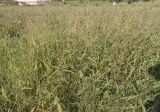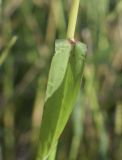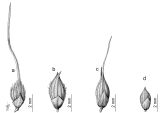
Часть соцветия. Испания, Каталония, пров. Жирона, комарка Баш Эмпорда, муниципалитет Калонже, залежь. 21.09.2025.
Svetlana Kourova CC BY-NC 2025
The marker on the map does not indicate the exact coordinates of the plant or lichen.
The marker does only indicate the conditional center of the terrain ("geographic point") where the photo was taken.
Open mapIdentification history
- 2025-09-26 Svetlana Kourova published it as Echinochloa.
- 2025-09-28 Svetlana Kourova identified it as Echinochloa colonum.
See also:
Discussion (17)
All photos of taxon (14)
Code of link to photo
| Create: | HTML or BBCode with preview |
| Code for linking on the web: | |
| This is how it will look: | 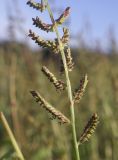 Echinochloa colonum on the site «Plantarium» |
Text to cite the page
Коурова С. 2025. Изображение Echinochloa colonum (L.) Link // Плантариум. Растения и лишайники России и сопредельных стран: открытый онлайн атлас и определитель растений. [Электронный ресурс] URL: https://www.plantarium.ru/page/image/id/852092.html (дата обращения: 11.11.2025).
Kourova S. 2025. Image of Echinochloa colonum (L.) Link // Plantarium. Plants and lichens of Russia and neighboring countries: open online galleries and plant identification guide. URL: https://www.plantarium.ru/lang/en/page/image/id/852092.html (accessed on 11 Nov 2025).
Views: 322Discussion
| Svetlana Kourova | Наверное Echinochloa crus-galli? |
| Dmitry Oreshkin | Ещё цветёт — видны пыльники. |
| Svetlana Kourova | Спасибо. Пыльники конечно же видела, но и зёрнышки вроде бы уже формируются. Какая-то непостижимая для меня задача — злаки в целом. Может конечно чаще их снимать нужно, пока руку и глаз не набъёшь?  |
| Dmitry Oreshkin | У осок тоже сложно понять, когда ещё цветение, а когда уже плодоношение. Живые пыльники или рыльца — пожалуй, единственный надёжный вреншний признак. |
| Lena Glazunova | Там, мне кажется, ещё и рыльца мохнатые видны. |
| Anna Malykhina | Ага, видно. |
| Dmitry Oreshkin | Светлана Коурова wrote: А какие ещё возможны варианты?Наверное Echinochloa crus-galli? |
| Svetlana Kourova | Вариантов четыре, вот ключ из Flora iberica (Том 19-II, 2021):
1. Raquis de los racimos sin setas largas; espiguillas de 2-2,8(3) mm de longitud, múticas, dispuestas en 4 filas; cariopsis blanquecina ............................... 4. E. colona – Raquis de los racimos con setas largas, ± abundantes; espiguillas de (2,8)3-5,5(6) mm de longitud, todas o en parte ± aristadas, dispuestas irregularmente; cariopsis amarillenta, pardusca o pardo-rojiza .............. 2 2. Vainas de las hojas basales con tonos purpúreo-violáceos; espiguillas (2,8)3-3,6(3,8) mm; cariopsis 1,4-2,2 × 1,3-1,8 mm, de ovoide a anchamente elipsoidal ......... 1. E. crus-galli – Vainas de las hojas basales de color verde, a menudo sin tonos purpúreo-violáceos; espiguillas (3,6)3,8-5,5(6) mm; cariopsis 2,2-3 × 1,9-2,5 mm, de elipsoidal a subesferoidal .. ...................... 3 3. Inflorescencia de ordinario muy inclinada, nutante en la madurez; espiguillas ancha- mente elíptico-ovoides, de ordinario con tonos purpúreos evidentes, al menos en las aristas; gluma inferior de 1/3-1/2 de la longitud de la espiguilla; embrión c. 3/4 de la longitud de la cariopsis ........................................... 2. E. oryzoides – Inflorescencia erecta o levemente inclinada en la madurez; espiguillas estrechamente elíptico-ovoides, verdosas, de ordinario sin tonos purpúreos evidentes; gluma inferior de 1/2-4/5 de la longitud de la espiguilla; embrión de c. 4/5 a subigual que la longitud de la cariopsis .............................................................................. 3. E. oryzicola |
| Svetlana Kourova | |
| Dmitry Oreshkin | У растения на фото остей не видно, что сокращает выбор. |
| Svetlana Kourova | Да уж, более на E. colona тогда похоже: и остей не видно, и колоски милиметра по 2 всего (постараюсь позже сфотографипрвать их на бумаге), с их расположением — в четере ряда или нерегулярно — мне пока не очевидно, ну и зерновки (посмотрела на собраном) скорее беловатые, чем желтоватые.
Проверю позже остальные части. |
| Svetlana Kourova | Нашла вчера в самом низу куртинки уже вовсю плодоносящего растения один побег с развивающимся соцветием (фото 0724).
Просматриваются по крайней мере достаточно ровненькие ряды колосков, возможно и четыре даже. Особенно заметно их наличие, если сравнивать с расположение колосков на вот этом растении (на нём они кажутся нерегулярными): 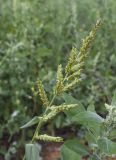 Сравнительные размеры соцветий -примерно в одной стадии развития- обоих растений (фото 0897)
Ну и размер колосков и окраска зерновок на фото 0889
Сравнительные размеры соцветий -примерно в одной стадии развития- обоих растений (фото 0897)
Ну и размер колосков и окраска зерновок на фото 0889 |
| Svetlana Kourova | И так, с этим кажется разобралась. Проштудировала описания во Flora ibеrica, тщательно сравнила признаки не упоминаемые в ключе, Прочитала рекомендуемую в соседней теме Александром статью Александр Эбель wrote: и вышла по обоим источникам на довольно отличный от прочих Ежовников E. сolona -у нас Echinochloa colonum-, туда и отправляю.
Ключ (не полностью) из статьи, предварён выше по тескту такой фразой: Вот хорошая статья про ваши ежовники: https://phytokeys.pensoft.net/article/79499/ Owing to nomenclatural and taxonomic uncertainties, the key is considered provisional; for a different recent interpretation, see Martínez-Azorín and Crespo (2021). 1 Fertile floret not disarticulating at maturity. Spikelets unawned. Fertile floret and caryopsis markedly humped. Inflorescence compact, usually contracted and with the axis often hardly visible, sometimes with spreading branches (Fig. 1) 2 1' Fertile floret disarticulating at maturity. Spikelets awned or not. Fertile floret and caryopsis not markedly humped. Inflorescence not strongly contracted when fully developed, with the axis showing through (but compare with clearly different E. muricata var. wiegandii when in doubt) 3 2 Spikelets dark brownish or purplish at maturity (Fig. 2), ca. 3–4 mm long. Caryopsis brownish E. esculenta 2' Spikelets pale (yellowish or greenish) at maturity (Fig. 1), ca. 3–3.5 mm long. Caryopsis whitish E. frumentacea 3 Spikelets < 3 mm long and lower glume ca. 1/2 length of the spikelet, which is always unawned. Axis of the inflorescence branches (almost) without bristles (except at the base). Inflorescence without secondary branches (Fig. 3). Leaves narrow, usually not exceeding 6 mm. Caryopsis whitish E. colona 3' Spikelets usually ≥ 3 mm long, awned or not. (If spikelet < 3 mm, then lower glume only ca. 1/3 length of the spikelet.) Axis of the inflorescence branches with bristles. Inflorescence often with secondary branches. Leaves usually wider. Caryopsis usually darker, yellowish or brownish 4 4 Spikelets ≥ 4 mm long and at least some spikelets with lower glume up to 2/3 length of the spikelet (Fig. 4D). Mature inflorescence more or less erect (Fig. 5). Spikelets unawned or with an awn up to 20 mm long. Caryopsis 2–2.4 mm long. Embryo at least 0.75 to over 0.9 length of the caryopsis. (An obligate weed of rice.) E. oryzicola 4' Spikelets ≥ 4 mm long and lower glume not longer than 1/2 length of the spikelet. Mature inflorescence drooping (Fig. 6). Spikelets usually awned, with an awn up to 50 mm long. Caryopsis 2.2–2.8 mm long. Embryo 0.65–0.75(–0.85) length of the caryopsis. (An obligate weed of rice.) E. crus-galli var. oryzoides 4" Spikelets ≤ 4 mm long and lower glume usually clearly less than 1/2 length of the spikelet. (If spikelets > 4 mm, see 6, E. muricata var. muricata. Solely a rare casual?) 5 5 Lemma of the fertile floret with a membranous tip that is clearly differentiated from the coriaceous body of the lemma (Fig. 7A); the membranous tip demarcated from the coriaceous body by a line of minute hairs (the latter, however, not or hardly visible with a hand lens). Palea of the fertile floret with a blunt, soft, frayed looking, usually strongly recurved tip (Fig. 7B). Spikelets unawned or awned; awn length extremely variable (up to 40 mm long or more). The leaf subtending the distal inflorescence with the demarcation between blade and sheath more or less semicircular or forming a slightly elongated upside-down U; blade usually patent from the base. (A complex taxon with several difficult-to-distinguish intergrading forms that are not keyed out here; see comments below.) E. crus-galli ... |
| Anna Malykhina | Отлично проделанная работа!!! Светлана, а добавьте в таксон дополнительные фото, пожалуйста! |
| Svetlana Kourova | Анна Малыхина wrote:
Спасибо, но осталось её ещё больше Отлично проделанная работа!!!  , разобраться со смесью сильно перекрещивающихся признаков у оставшихся трёх, которые и сами по себе очень вариабельны и, к тому же, неразберихи у ученых с их таксономическими принадлежнастями только набирают обороты , разобраться со смесью сильно перекрещивающихся признаков у оставшихся трёх, которые и сами по себе очень вариабельны и, к тому же, неразберихи у ученых с их таксономическими принадлежнастями только набирают обороты 
Светлана, а добавьте в таксон дополнительные фото, пожалуйста!   |
| Anna Malykhina | Да, и соцветия на бумаге тоже. Спасибо! |
| Svetlana Kourova | Добавила два фото. Соцветие на бумаге не стала, на нём два разных экземпляра и скорее всего два разных вида. А отрезав только нужное, кадр получится слишком длинным по одной стороне, пусть уж тут и остаётся. |
